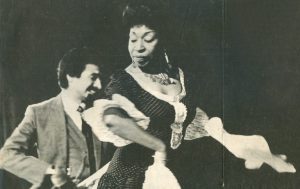Victoria Santa Cruz (Victoria Eugenia Santa Cruz Gamarra) is widely considered the mother of Afro-Peruvian dance. Born in Lima, Peru, on October 27, 1922, she was the eighth of ten children. Her father was Nicomedes Santa Cruz Aparicio, and her mother, Victoria Gamarra Ramirez. Her father worked as a playwright and her mother was an accomplished singer and dancer of traditional Peruvian styles.
Growing up, Santa Cruz acquired a basic understanding of theater and dance from her parents. Her father, who spent a great deal of his early life in the United States (1876-1905), was exposed to Shakespearean plays and European classical music. Santa Cruz took an early interest in these teachings, co-founding and directing the first black-owned theater in Peru with her brother, despite no prior formal education. She then used this opportunity to produce three plays, most of which showcased the daily racial conflict of Afro-Latinas. Her first notable play, Malató, was released in 1961 and explored the relationship between enslaved people and their oppressors.
After early successes, Santa Cruz began studying theater and choreography at the Université du Théâtre des Nations and École Supérieur des Études Chorégraphiques in Paris in 1961. While she received significant attention for her plays, she also received recognition for her unique, Afro-Peruvian styled costumes. She graduated in 1965 and visited Africa later that year. There, she staged the ballet La muñeca negra (1965), which acted as a reclamation for lost cultural memories due to slavery. However, one of Santa Cruz’s most significant accomplishments did not occur in Africa, or even her native country, but in Mexico City during the 1968 Olympics.

Victoria Santa Cruz
Image Courtesy: Royal Gazette, Fair use image
Teatro y Danzas Negras del Perú, a group that Santa Cruz founded in 1966, was offered the prestigious award of performing at the Olympics after only two years of formation. These performances re-energized Afro-Peruvian dance forms such as the zamacueca and landu and introduced them to the rest of the world.
Furthering her career in the arts, Santa Cruz developed her first song, Cumanana (a word that symbolizes the mixture between Spanish and Black) in 1970. Then, almost a decade later in 1978, she performed one of the most impactful poems of her time, Me gritaron negra, which explored her transition from shame to pride in her race. In 1973, Santa Cruz was chosen as the founding director of the National Folklore Ensemble and continued to serve in that position into the 1980s. From 1982 to 1999, she was a professor of drama at Carnegie Mellon University in Pittsburgh, Pennsylvania.
After an artistic career lasting 53 years, Victoria Santa Cruz died in Lima, Peru on August 30, 2014. Her legacy and impact on the culture continues to be celebrated. In October 2021, Peru’s Ministry of Culture launched the Victoria Santa Cruz Centennial with programs and activities. In addition, the Fulbright Commission in Peru launched the Victoria Santa Cruz Fulbright Grant to Afro-Peruvians perusing graduate study in the United States.


